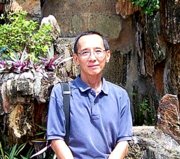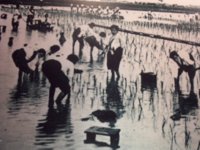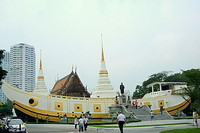- Home
- Bangkok Museums
- Yannawa Museum
Yannawa Museum
my neighbourhood history
By Eric Lim
The Yannawa Museum covers the history of Yannawa district in Bangkok that used to have fruit orchards, vegetable gardens and fishermen. The district got its name from Wat Yannawa, the boat temple.
According to my postal address, I don’t live in Yannawa, but it’s just across the street barely 10 m away!
I’ve walked through Yannawa for more times than I can remember and finally I got down to finding out more about the history of my neighbourhood.
This simple museum is housed in a two storey Thai house within the grounds of Wat Khlong Phum in Rama III Road.
Let’s take a virtual tour of the Yannawa Museum and find out more about the history, way of life, people, places and festivals in this district.

Yannawa Museum
Brief history of Yannawa
Yannawa (yan – craft, nawa – boat, ship) district used to be much bigger than what it is today (see shaded area in map). It used to include what is now Sathorn and Bang Kho Laem districts. This area is bounded by Sathorn and Rama IV Roads to the north and the Chao Phraya to the south.
Map of Yannawa district
View Yannawa district in a larger map
It wasn’t called Yannawa then but Ban Tawai because many people from Tavoy, a coastal town in southern Myanmar lived here since the reign of King Rama I (1782 - 1809). The Tawai were buffalo traders and lived in a place called Ban Khok Kwai (buffalo corral) by the Chao Phraya near the present day Taksin Bridge.
Even the temple nearby built in the Ayutthaya period was called Wat Khok Kwai. In the reign of King Rama III (1824 – 1851) a life-sized Chinese junk was built to house the chedi. The temple became known as Wat Yannawa or boat temple.

Chedi at Wat Yannawa
The district and sub-district of Ban Tawai adopted the name Yannawa as well. Like Phra Khanong district, Yannawa was initially a district in Phra Pradaeng province across the river, not a district in Bangkok.
In 1972 when Bangkok Metropolitan Authority was formed, Yannawa became a district in Bangkok. Later in 1989, when the population in the district got too big to manage, two new districts of Sathon and Bang Kho Laem were created from the original Yannawa district.
Old way of life
Yannawa district was near the Chao Phraya River and had numerous canals for irrigation. Fishing and agriculture were the main occupations and there were many fruits orchards, vegetable gardens and plantations of lychees, bananas and coconuts in the district.
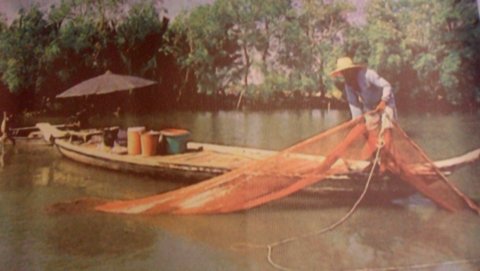
Fisherman in Yannawa
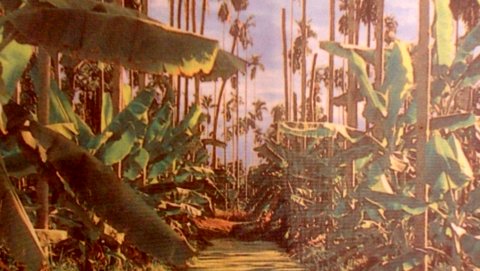
Banana and coconut plantation in Yannawa
There are a number of exhibits in the Yannawa Museum to remind us of this heritage. Residents have donated the actual items or models.
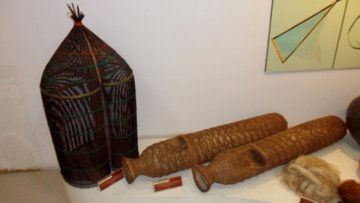
Fishing traps
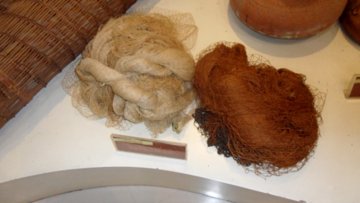
Fishing nets
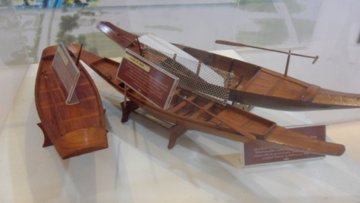
Model fishing boats
The Chong Nonsi Canal was one of the main canals flowing through the district along with several other smaller ones. Bridges were built at three locations along Chan Road and were numbered as; Saphan 3, Saphan 4, Saphan 5.
People and places in Yannawa
When I went upstairs to the display room, the first thing I was shown was this box stacked with old documents.
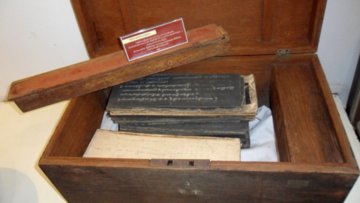
The old box
The old documents were actually medical text books on traditional Thai medicine painstakingly written with the Chinese calligraphy brush and ink on parchment and the bark of the Urticaceae*.
*The nettle family of herbs, shrubs, small trees and vines found in tropical areas

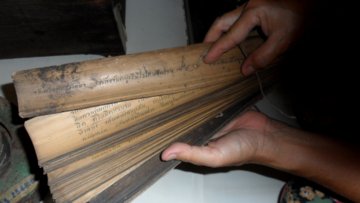

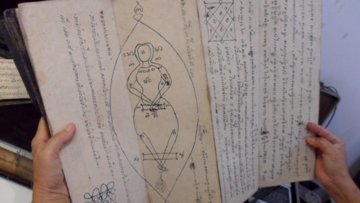
Medical text books
The box and its contents were donated to the Yannawa Museum by Mrs. Prator Chantrakul who inherited it from Mr Khram a famous practitioner of traditional Thai medicine in the Khlong Phum and Chong Nonsi area.
There were few roads in Yannawa in early days. In 1917, one resident of Yannawa, Duan Sathu and his younger brother Aek organised the local residents to dig a canal and use the earth to build a road.

Duan Sathu
The road stretched for a distance of 1, 869 m. In 1960, the district officer of Yannawa extended the road all the way to the river. They named the road Sathu Pradit Road* in honour of Duan and Aek Sathu.
*The original road built by Duan Sathu started from Saphan 4 (junction with Chan Road) to Sathu Pradit Soi 43. The extension goes all the way to the Sathu Pradit pier on the Chao Phraya.
One quaint account I will always remember is about a lady who owned a large lychee plantation in Yannawa which was blocking the construction of a road.
However, she bequeathed her plantation to the city of Bangkok. After her death they built a road through and aptly named it Nang Linchi (Mrs. Lychee) Road.
Rungroj Nopnarathip was born and grew up in Nang Linchi. His great-grand-father had an areca palm plantation in Nang Linchi. These were the palms that produced areca nuts that are chewed with betel leaves.
Rungroj’s parents recall the area had only paths for walking and cycling. When Yaowarat, Bangkok’s Chinatown got too crowded the Chinese moved to this area.
Some started growing betel plants; that’s how Suan Plu (betel plantation) got its name.
Others cultivated coconut, guava, banana and other fruits and vegetables in the area around in Chan Road and Sathu Pradit Road. A very popular fruit was lychee and there was a lychee plantation around St Louis Soi 3.
Festivals and games
Festivals
During Songkran in Yannawa there’s special ceremony at Wat Khlong Phum to change the robes for a revered monk, Luang Pho To. Residents make merit by offering alms to monks for three days.
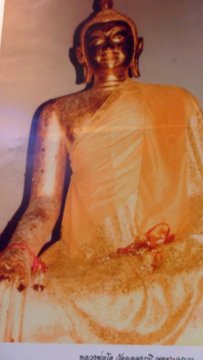
Luang Pho To
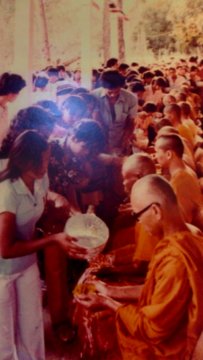
Three days of merit making
This is followed by a procession in the neighbourhood ending with a procession around the ubosot three times before the robes are changed. After the formal ceremonies, there are the usual fun and games.
Here are some photos of these festivities both past and present recorded in the Yannawa Museum.
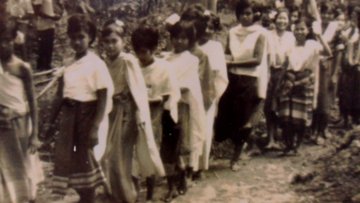
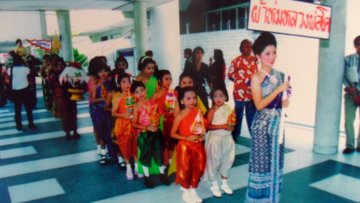
Procession at Songkran
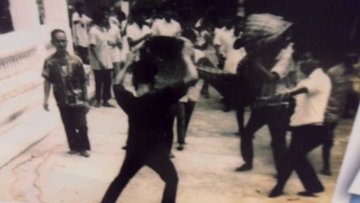

Lion dance
Games children play
One section of wall in the Yannawa Museum features some of the games children played in the old days. These were simple games made from local material and don’t cost very much. With the advent of smartphones and computer games, I doubt if such games will appeal to the kids today.
Holes are drilled in these coconut shells. A string is passed through the hole and a knot is made on the inner side to secure the string. The girls walk with these shells in a race.

Coconut shell race
A "horse" made from the stem of a banana leaf. The boys will mount these "horses" and run in a race.

Horse race
Temples in Yannawa
Yannawa district is home to both the Theravada and Mahayana sects in Buddhism and there are several temples with very special features.
Wat Chong Nonsi, built during the Ayutthaya period in the reign of King Narai the Great (1656 – 1688). The temple is renowned for its beautiful murals in the ubosot (ordination hall) depicting the 10 reincarnations of Buddha and related stories, including the demon Mara tempting Buddha before He attained enlightenment.
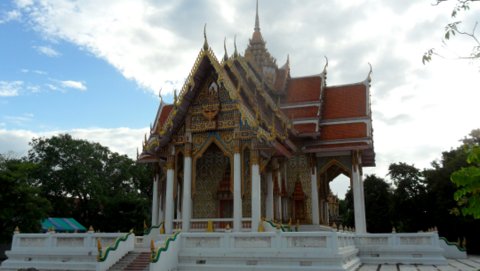
Wat Chong Nonsi
Wat Khlong Phum, where the Yannawa Museum is located, has a beautiful ubosot or ordination hall where the procession takes place during Songkran, the Thai New Year.
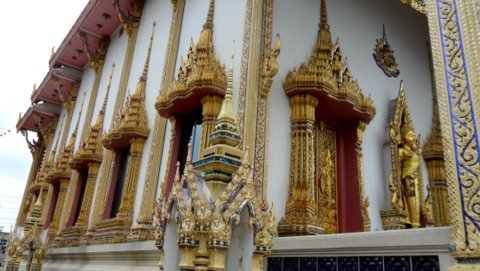
Wat Khlong Phum
What struck me about Wat Dan were the elaborately carved murals on the outer surface of the walls around one of the buildings.

Wat Dan
Here’s a close-up of some of these three-dimensional murals.
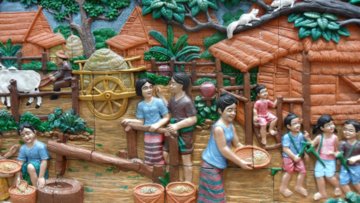
Village life
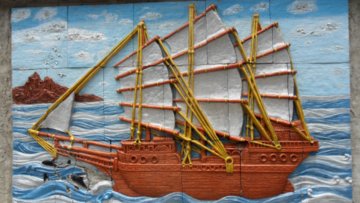
Chinese junk
Wat Phoman Khunaram is a relatively recent temple built in 1959 with a blend of Chinese, Tibetan and Thai architecture. The temple is a Chinese Mahayana Buddhist temple built by Pho Chaeng, a Chinese spiritual master who was the first abbot.

Wat Phoman Khunaram
Other temples in Yannawa are Wat Chong Lom, Wat Pariwat and Wat Dork Mai.
Yannawa today
What’s Yannawa like today? It’s a far cry from the days of old. Condominiums, malls and offices towers have replaced all the orchards and villages. The fishermen are gone except for the hobby fishermen at the various boat piers along the Chao Phraya which are no longer in use.

New mall in Narathiwat Road
Sathu Pradit Road remains a bustling commercial area with street vendors and small shops dealing in various goods and services on the ground floor and residences upstairs. The older folks still remember the man who built the road and pray for him on auspicious occasions.

Chinese shrine in Sathu Pradit Road
The scene in Sathu Pradit is typical of life in the district. However in some of the popular places, landlords are starting to sell off their properties in favour of more lucrative developments.

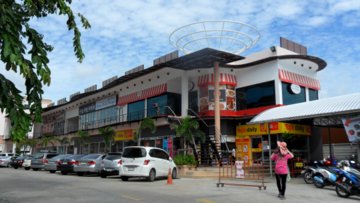
The changing face of Nang Linchi
Many of the old closely knit communities are still around in the soi off the main roads.
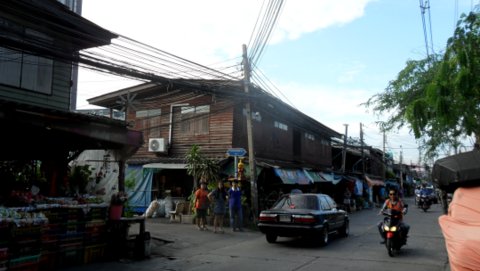
Communities off Narathiwat Road
To solve traffic congestion, a road was constructed to provide a direct link from the port at Khlong Toei to the industrial areas in Samut Prakarn. Called the Industrial Ring Road, it spans the base of the horse-shoe bend in the Chao Phraya at Phra Pradaeng with a spectacular multi-span suspension bridge.

Bhumipol Bridge1 or Industrial Ring Road Bridge
Many of the canals in Yannawa are still there. The Chong Nonsi Canal is one of the main canals, flowing under the skytrain station of the same name, along Narathiwat Road to the Chao Phraya River.

Chong Nonsi Canal along Narathiwat Road
Several other smaller canals run south into the Chao Phraya as can be seen from the map. The bridges Saphan 3, Saphan 4, Saphan 5 are gone but local residents, taxi and tuk tuk drivers still use these names as points of reference.
In the process of reorganisation, kwang (sub-district) Yannawa ended up in Sathorn district together with Wat Yannawa, the boat temple that gave the district its name.
Map to the Yannawa Museum
View Yannawa Museum in a larger map
How to get there
Take the Green Line (BTS Sky Train Silom Line) to S3 Chong Nonsi Station. Walk across the link bridge to the Sathorn BRT Station, Bangkok BRT ( bus rapid transit service).
Unfortunately the museum is mid-way between two BRT stations and it’s a little too far to walk.
Alight at the Wat Dan BRT Station and take a taxi to the museum. Or you can take a taxi from S3 Chong Nonsi Station all the way to the museum.
Opening times
The Yannawa Museum is open from Wednesday – Sunday from 1000 – 1630 hours. It’s closed on Mondays and Tuesdays
Admission is free
Contact information
Yannawa Museum
Wat Khlong Phum
Rama III Soi 46
Chong Nonsi
Yannawa
Bangkok 10120
Tel: +66 2284 3048
My thanks
I am very grateful to Khun Narirat Pinthong, the administrator of the Yannawa Museum for all her assistance during my visit to the museum. As someone who lives in Yannawa she was able to brief me thoroughly on the exhibits in the museum.
The brochures and booklets she provided were a wealth of information on old Yannawa. What the museum lacked in exhibits, she more than made up with her knowledge and enthusiasm.
I am also grateful for the long kong and bananas she gave me as a parting gesture. The legacy of fruits in Yannawa lives on.
My thanks also go to Mr. and Mrs. Nopnarathip long-time residents in Nang Linchi for sharing their memories on what the area was like 50 years ago. Their son Rungroj, a good friend of mine, still lives in Nang Linchi where he was born. My thanks to him as well.
This article is dedicated to the people in Nang Linchi, their cheerful and pleasant manner has always been a comfort to me.
For more Bangkok Museums.
Tour Bangkok Legacies – my first e-book
If you are an independent traveller, here's a handy e-guide book, Tour Bangkok Legacies, which will help you along as you explore the streets of Bangkok and discover its old treasures. It's complete with historical descriptions, maps and detailed directions on how to get to these places.
My Kindle e-book
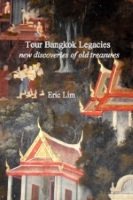
Search Tour Bangkok Legacies with DuckDuckGo
Related pages
My Journey through Thailand
Part I The First Steps
My Kindle edition

My Smashwords edition


